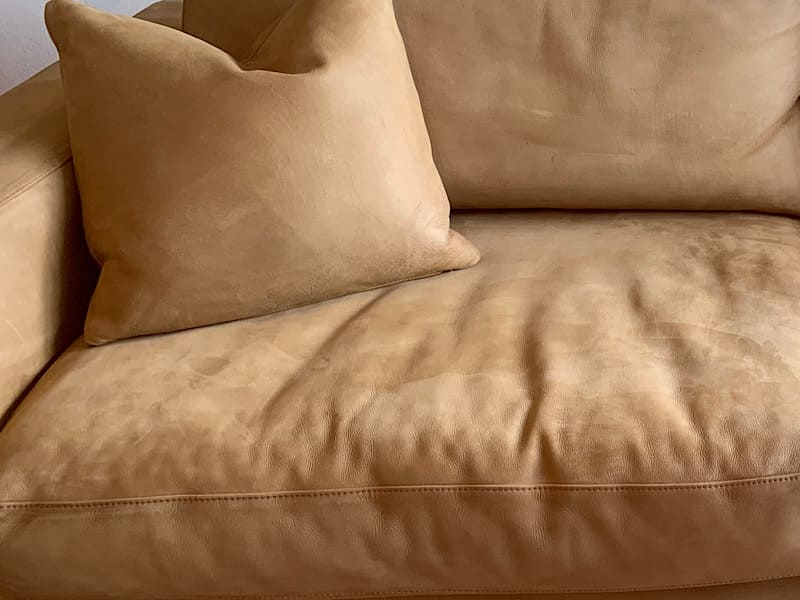In this article, we continue the fascinating explanation of how leather is dyed in a wide range of colors, where creativity in dyeing processes plays an important role in achieving the desired color shade. Visit this link (PART I) if you haven’t read the first part yet. Next, we will explore the different types of finishes in the leather dyeing process. Finishes are equally important as the dyeing itself, as they help enhance the appearance of the color and the leather product in which they are used.
Leather Types: Aniline (or Full Grain), Nubuck, and Suede
These types are obtained using semi-transparent aniline dyes. As a result, natural marks or scars on the leather or hide are still visible through the finish. Known for having the most expensive finish, full-grain or aniline leather has astonishing softness.
 The unique and elegant appearance of aniline leather
The unique and elegant appearance of aniline leather
While the Nubuck finish, and often also the suede finish, is achieved by brushing the leather surface until a soft, velvet-like feel is obtained.
 The soft appearance of Nubuck and Suede
The soft appearance of Nubuck and Suede
Two-Tone or Dual-Tone
Referring to spraying a second color or lightly rubbing by hand over the original color is what dual-tone finishing is about. There is no right or wrong for this finish, although it gives the leather a distinct appearance.
Metallic or Pearlescent
The use of metal flakes to reflect light and change the leather’s sheen is the characteristic of the metallic or pearlescent finish. This finish can be applied to any pigmented leather to give it a special effect and appearance.

Transparent
Often found on Nubuck and aniline leather; this finish allows a more natural look where granular textures, or any type of scar and natural mark, are visible. This finish is best applied by hand on the leather.
Hybrid or Semi-Aniline
When a light protective layer (top coat) is applied along with a hand-applied pigment dye to any aniline leather, the surface has some distinct qualities giving it a pigmented leather appearance. Typically, this is done to cover imperfections or to add durability to the leather.
Wax and Oil Finishes
A leather treatment that uses a wax or oil finish to give the leather a unique look and feel, often found in a small percentage of leather goods. These types of finishes are not repairable, unlike any other type. Wax and oil are the components that prevent dyes from being absorbed or adhering to the leather.
Types of Final Applications on Leather
Hand Wipes or Sponge
Used to change the leather’s look and appearance, this type of application involves passing a sponge or wiping leather dye over an existing color. Whether you choose to use a cloth, sponge, or any other applicator to create a distinct effect. This is also a good way to achieve a two-tone effect as mentioned earlier.
Brush Finishes
This type of finish is often used when repairs are needed, as it helps blend the color and create designs. However, brush strokes are hard to hide. Foam brushes work best for applying leather dye to small surfaces.
Sprayers
Considered the best way to apply leather dye, especially when multiple light layers are needed for the repaired area to blend well. An airbrush or touch-up spray gun gives better control over the area and the pattern you are working on.
Black Leather with Vinegar and Rust
An old but economical technique for dyeing leather jet black is the method in which vinegar is used. The result is a mixture of vinegar and rust, where the color does not rub off on fingers, clothing, or anything else it comes into contact with. Additionally, this homemade leather dye can be stored for later use, which is another notable advantage.
This method works especially well with vegetable-tanned or old leather. If the leather is already dyed, it is probably chrome-tanned and sealed, so vinegar will not produce positive results.
Regarding rust, from bare iron nails, iron shavings, to any other material that will rust, or is already rusted, serves this purpose.
Steel wool is one of the fastest options to date, as it can be broken into smaller fragments. Remove the oil layer that prevents rusting by soaking it in acetone, squeezing it, and then letting it dry completely.
 These locks hold the keys to ideal homemade leather dyeing
These locks hold the keys to ideal homemade leather dyeing
After heating about half a gallon (two liters) of white vinegar or apple cider vinegar until warm but not too hot to touch, pour it back into the original container or any available container.
When the metal is placed in the vinegar, after some time, it reacts with the vinegar (acetic acid), forming a substance called ferric acetate, which in turn reacts with the leather to dye it. The amount of iron to add depends on the vinegar’s concentration.
The simplest way would be to start with a large amount (about thirty nails) and then keep adding metal until it stops dissolving. Next, keep it in a warm, ventilated container for at least a week. Make a hole in the lid to release gases, or the container could explode.
With the lid closed and placed in the location for at least one or two weeks, the vinegar will be ready when all the iron has dissolved and there is no vinegar smell. If there are still traces of vinegar smell, add more iron. Then, heat it on the stove to speed up the process. Once the acetic acid is gone, any remaining iron will rust normally, turning the liquid a deep reddish color.
At this point, it is fine to leave the lid open for a few days to help the last traces of acetic acid evaporate. Straining is important at this stage, so filter the liquid by passing the vinegar through paper towels or coffee filters repeatedly until the liquid is free of solids.
Looking for Leather Garments and Accessories in Top Colors and Finishes?
Qiwa is a family business that for 30 years has been dedicated to the production of leather goods, accessories, automotive upholstery, and jackets with high standards of quality and design. At Qiwa, we develop premium leather products of the highest quality, with our brand and with brands from various designers, supporting multiple entrepreneurial projects.
We offer a wide variety of items in different models, either with finishes to your liking from our catalog, or custom-made according to your preferences, with a wide range of colors and personalized finishes.
Learn more about our history here and our product catalog here. You are also invited to contact us directly here.